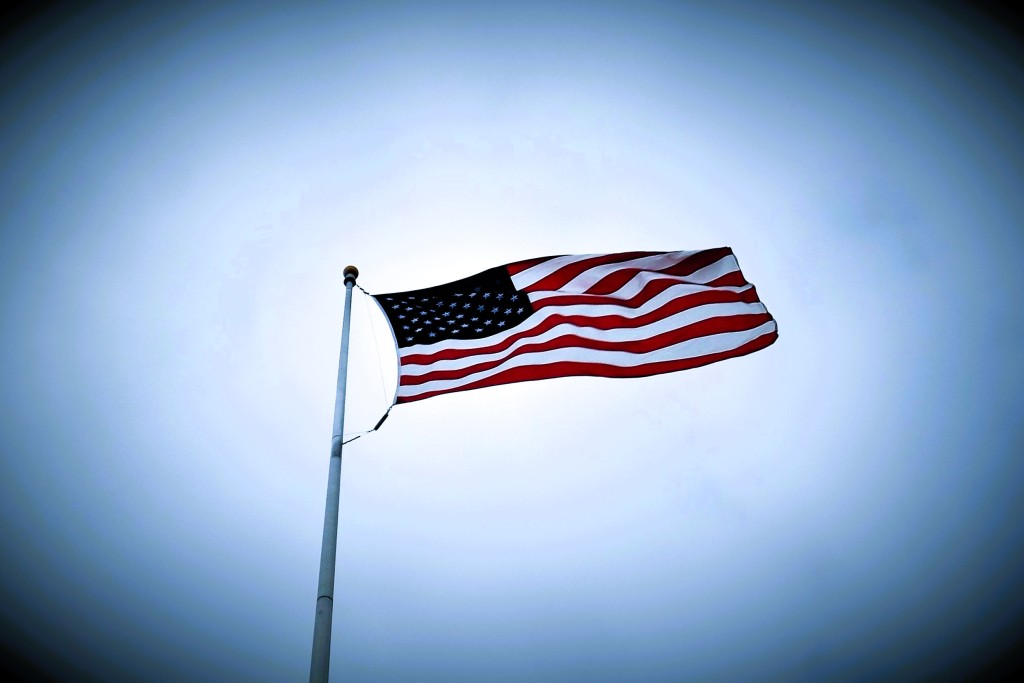Memories: some memories from childhood are as fresh as the morning dew on trilliums outside the living room window. One of those memories is how we began each school day in elementary school.
We would rise from our seats and place our right hand over our hearts. The teacher would discourage lefties and insist with that infamous ruler of discipline in her right hand that it had to be the right hand on the heart—the left hand was unpatriotic.

We faced the national flag in the corner and repeated from memory:
“I pledge allegiance to the flag of the United States of America, and to the republic for which it stands, one nation under God, indivisible, with liberty and justice for all.”
It was unknown to us the history of that pledge and the controversy surrounding it over the decades. The original pledge was first introduced in in The Youth Companion on September 8, 1892:
“I pledge allegiance to my Flag and the Republic for which it stands, one nation, indivisible, with liberty and justice for all.”
In order to ensure that immigrants were pledging allegiance to the USA and not to their country of origin, in 1923 the following was added:
“I pledge allegiance to the Flag of the United States of America and the Republic for which it stands, one nation, indivisible, with liberty and justice for all.”
In 1954 at the insistence of President Dwight David Eisenhower the words “under God” were added . There were protests about this addition, but with “godless” Communism spreading around the world and on the home front, Congress wanted to make a bold statement that the USA was a nation under God—the God of the Bible.
Being young we did not fully understand that the ideal of “liberty and justice for all” was limited in our country. Our neighbors across town were not ascribed that ideal as well as many people in various parts of the country who were oppressed and separated from what the ideals of the pledge insisted were the right of every American.
Even today, the pledge has not reached its true ideal. The fight continues for justice for all.
The national flag in the corner of the school room of our youth will be celebrated this week: June 14th is Flag Day. Its history can be traced back to the Revolutionary War.
The Second Continental Congress on June 14, 1777 adopted the current flag design representing “a new constellation” among the nations. It pointed toward the heavens as a symbol of what was to be a special place on Earth.

President Thomas Woodrow Wilson’s Proclamation of May 30th 1916 for Flag Day on the 14th to be a national observance
“…I therefore suggest and request that throughout the Nation and, if possible, in every community the 14th day of June be observed as Flag Day, with special patriotic exercises, at which means shall be taken to give significant expression to our thoughtful love of America, our comprehension of the great mission of liberty and justice to which we have devoted ourselves as a people, our pride in the history and our enthusiasm for the political program of the Nation, our determination to make it greater and purer with each generation, and our resolution to demonstrate to all the world its vital union in sentiment and purpose, accepting only those as true compatriots who feel, as we do, the compulsion of this supreme allegiance. Let us on that day rededicate ourselves to the Nation, ” one and inseparable,” from which every thought that is not worthy of our fathers’ first vows of independence, liberty, and right shall be excluded, and in which we shall stand with united hearts for an America which no man can corrupt, no influence draw away from its ideals, no force divide against itself, a Nation equally distinguished among all the nations of mankind for its clear, individual conception alike of its duties and its privileges, its obligations and its rights…”
GPO-CRECB-1916-pt9-v53-14-2.pdf (govinfo.gov)
It is of note that that President Wilson was “encouraged” by Dr. Bernard John Cigrand, a current dentist and a former schoolmaster, to make June 14th the flag’s official birthday.
Cigrand’s efforts began in the 1880s. He was a first-generation American who loved his country and served in World War I.
In the links below are snippets of his story. Truly, a remarkable patriot and individual.

The annual observation of Flag Day was made official on August 3, 1949 when President Harry S. Truman signed the following:
H.J. Res 170 (81st Congress)
“Joint resolution designating June 14 of each year as Flag Day.” page 11106 of the Congressional Record House
Congressional Record | Congress.gov | Library of Congress
It is not an official federal holiday even though in places it is observed as one. In many ways it is a day which can slip by without notice since the countdown from Memorial Day is the 4th of July.
However, the ideal of a “new constellation” and “our determination to make it greater and purer with each generation” is still a work in progress for all the people who call this land home and those thousands who travel to our borders each year reaching for the ideal American dream. A dream is a hope unfulfilled today but still cherished for tomorrow.
G. D. Williams © 2024
POST 1038

The Pledge of Allegiance
The Pledge of Allegiance (ushistory.org)
Pledge of Allegiance to the Flag of the United States of America | History & Text | Britannica
The Pledge of Allegiance – The U.S. Constitution Online – USConstitution.net – U.S. Constitution.net
The Pledge of Allegiance | The American Legion
Pledge of Allegiance – Wikipedia

Flag Day
Flag Day | Definition, Date, Meaning, History, & Facts | Britannica
Flag Day’s long—and surprising—history explained (nationalgeographic.com)
Bernard John Cigrand (October 1, 1866 – May 16, 1932)
Bernard J. Cigrand is considered by many to be the “Father” of Flag Day as we know it today. Working as a school teacher in Waubeka, Wisconsin, Cigrand arranged for his pupils at Stony Hill School to celebrate the American flag’s ‘birthday’ on June 14, 1885. This celebration marked the 108th anniversary of the official adoption of the Stars and Stripes. Shortly after this celebration, Cigrand moved to Chicago, Illinois, to attend dental school. His dedication to observing the birthday of the flag did not stop with his move. In June 1886, he publicly proposed an annual observance of the flag birthday in an article entitled “The Fourteenth of June,” published in a Chicago newspaper. His efforts remained steadfast in the years to come.
In 1888, Bernard Cigrand spoke before the Sons of America, a group dedicated to the preservation of the American flag and the American way of life, to promote the appropriate reverence for American emblems. Cigrand was appointed editor-in-chief to the organization’s magazine, American Standard, and would continually write articles enthusiastically advocating a ’flag day.’ Cigrand also advocated for a ’flag day’ in numerous other magazines and made many public speeches. He would later note that he had given over 2,188 speeches on American patriotism and the flag. Cigrand would become the president of the American Flag Day Association as well as the National Flag Day Society. These organizations provided financial support and national backing to his cause.
The Father of Flag Day: Bernard Cigrand | National Postal Museum (si.edu)
It was after he became a schoolteacher at the age of nineteen and conducted classes at the little country school at nearby Stony Hill or Schumacher’s Hill that Cigrand conceived the idea of observing June 14 with fitting ceremony as the “birthday of the Flag,” bearing in mind that Congress had officially adopted the Stars and Stripes as the Flag of the United States on June 14, 1777.
In the role of $40 per month schoolteacher, he held the first observance of Flag Day in 1885, where observers recall the small American Flag that stood in a bottle on his schoolroom desk…
Never once through these years did Cigrand falter In his crusade to have June 14lh recognized as a national holiday when Americans might pay homage, to the national emblem. He made his first public proposal of the idea in June 1886, through the medium of the Chicago Argus, and he campaigned tirelessly thereafter in newspaper and magazine articles, in books and on the lecture platform, advocating recognition of this memorable day as “Flag-Birth-Day.” In an address to the Sons of America in June 1888, he emphasized the good that would come from a flag holiday and as a result, that organization undertook the publication of a magazine called the American Standard to inculcate reverence for American emblems…
But the crowning achievement of his life had come at the age of fifty, when President Wilson, on June 14, 1916, had issued a proclamation calling for a nation-wide observance of Flag Day. Cigrand had also assisted in forming the Pledge of Allegiance to the Flag in 1889 and had later petitioned President Wilson to urge its acceptance by the War Department.
The Sheboygan Press, Sheboygan Wisconsin: Friday, June 14, 1946, Page 4
The Father of Flag Day – Pieces of History (archives.gov)
Bernard J. Cigrand (1866-1932) – Find a Grave Memorial
DID YOU KNOW? – Chicago Tribune
All Photos in this post © 2024 G. D. Williams. May be used on the web if proper credit is given to this blog.
